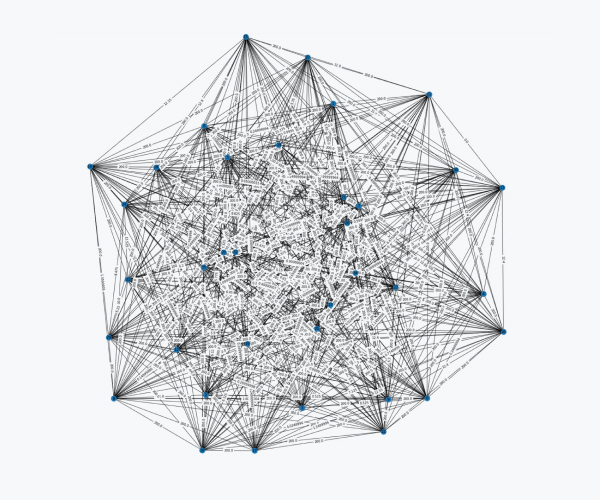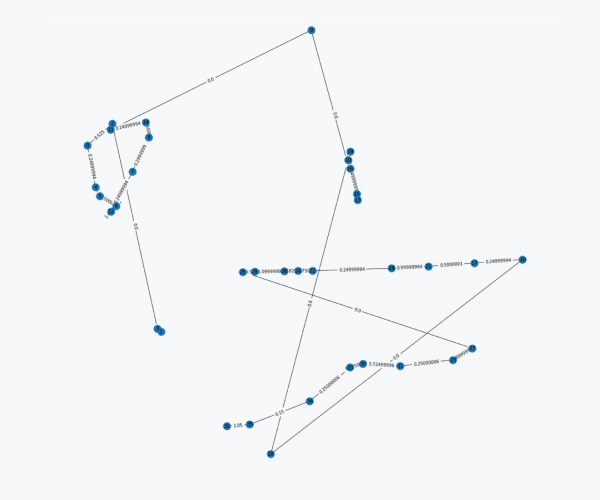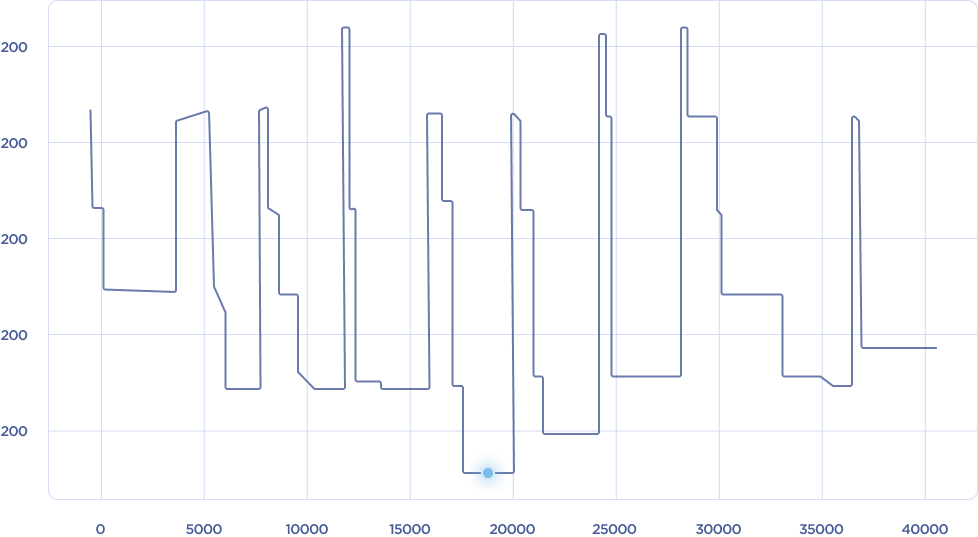quantum systems
High-performance computing
that creates business value
that creates business value
Estimation of optimal sequence of feeding steel coils to the continuous hot-dip galvanizing machine. This case demonstrates that quantum algorithms work successfully even without quantum computers.
The coils to be fed into the galvanizer have different geometry and the finished product has to have different coating thickness and a variety of other parameters, depending on the batch and each individual customer. As a result, reconfiguration of the machine is often required during the transition from one coil to another, and sometimes so-called «transitional» coils from the stock storage are used to achieve a smooth transition from one coil to another. The more such operations occur, the less efficient the line is.


The output has different coating thickness and other parameters that are tuned for each customer individually;


Incoming coils have different geometry;


During one shift one machine can process from 30 up to 100 coils.
To solve this case QuSolve used the Hamiltonian path quantum algorithm simulated on a classical computer. This algorithm can be used for a wide range of manufacturing and business tasks: optimal path search, vehicle loading schemes, job shop scheduling.



This solution doesn't require any special computing equipment, therefore, takes a small time to implement.
Two-fold reduction of coil transition costs compared to the Ant colony algorithm, which in turn is 4-5 times more effective than a conventional greedy algorithm. Also the computing time was reduced by almost a hundred times - just around 1 second for a batch of 40 coils on a desktop computer.
Optimal slabs loading system that reduces the number of railway carriages required for transportation.
Minimize the cost of freight, taking into account the difference in freight rates for various carriage types and destinations, batch discounts and business limitations.
Сarrying capacity, geometry, serviceability and availability of carriages for each destination;
Forwarder’s technical conditions that take into account absolute and relative weight constraints, geometry, mutual placement of slabs and centering limitations which results in 174 available loading schemes.
Software is integrated into the customer's ERP system, has an intuitive web interface for loading scheme visualization. Implementation time estimate starts at7 days.


Testing period: 15.03.21 – 16.03.22


Batches: 6 964


Carriages: 93 695


Annual savings on freight – 5,1%


Transportation cost was cut for 87% of batches


NPV - 2,4 billion rubles.
The Russian company QuSolve is developing its own solver – it is a complex software that calculates the best solution for a user-defined scenario, it is used to optimize business processes in industry and logistics. Solver Solver will be the first domestic product of this kind and will be able to replace foreign analogues that are currently used in Russian industry, including at backbone enterprises. The release is scheduled for the second half of 2022.
QuSolve company solves complex optimization problems for industrial enterprises. For example, to optimize the transportation of products by rail, you need to sort through millions of scenarios. Classical computers will be sorting through them for decades, and existing quantum computers do not even allow us to approach such tasks yet. The QuSolve team has learned how to take advantage of quantum computing on classical computers and quickly perform complex calculations — this is what a solver is for.
Until the beginning of 2022, QuSolve did calculations on the Japanese Fixstars solver. Now the team is using its own development in test mode. Our own solver allows QuSolve to speed up calculations and personalize them even more for the client. Business processes are dynamic, so you need to have access to the solver's internal program code in order to quickly change settings, adapt them to the situation, and collect system behavior statistics.
QuSolve plans that its solver will successfully replace analogues from foreign providers that left the Russian market in March 2022. Among other things, we are talking about IBM, which is promoting its CPLEX solver, and another American company, Gurobi. QuSolve also plans to provide its solver to other computing companies. This will allow Russian players to remain independent of foreign decisions.
“In Russia, as you know, there is no shortage of strong mathematicians and engineers, but they work mainly on foreign software and equipment. This limits the applicability of solvers in solving problems existing in Russian business. By releasing our own solver, we will be able to completely close the loop of calculations within the company and thus ensure 100% import substitution of optimization calculations for industry,” explains Dmitry Vasilkov, founder and CEO of QuSolve.
Combinatorial optimization problems can be found in many areas: from sorting city bikes by stations to the optimal location of oil wells. For each client, QuSolve analyzes production processes and offers solutions for their optimization. The largest client is NLMK. QuSolve is the first company in Russia that not only solves high-tech business tasks, but also advises on a number of aspects in the implementation and integration of quantum computing in industry. He is a resident of Skolkovo.
Mathematicians use quantum computing to solve complex industrial problems.
According to Rosstat, more than 61 million tons of steel and another 66 million finished products were produced in Russia in 2021. To cope with such volumes, it is necessary to establish tens of thousands of production processes, logistics, connect millions of people, machines, pieces of equipment scattered throughout the country. And each process requires precision and speed.
One of the ways to efficiently and quickly cope with tasks of this scale is to use algorithms inspired by quantum technologies (quantum-inspired). In industry, and in particular in metallurgy, they are used where it is necessary to optimize production costs, reduce time, energy, resources, and even reduce the impact on the environment. In Russia, only a few teams of applied mathematicians are working on such algorithms, and in terms of industrial applications, they are in many ways ahead of their Western colleagues.
A data transmission system based on quantum physics has been created in Taganrog
"Any process where there is a word "schedule", "sequence", "schedule", includes optimization tasks. In some cases, the result can be obtained without complex calculations, and it will be quite accurate: for example, when drawing up a school schedule," Dmitry Vasilkov, CEO of Quantum Systems, told RG. - But even here there may be a mistake in the combination and then the schedule will be inconvenient for students or teachers. If you use more complex calculations, you can make more accurate optimization and take into account the interests of all parties, then the schedule will save teachers' time by several percent and simplify the logistics of students. In the case of a school, this may be a minor effect. But if we are talking about large-scale production, optimizing work by only a few percent means saving a lot of resources."
Optimization problems are solved by searching and matching combinations, the expert explains. A small number of variables can be sorted out on the computer. For example, the product of all natural numbers from 1 to 6 or 6! is 720 different sequences, and 10! is already 3,628,800. The number of steps grows very much as the size of the task grows. "So, optimizing the schedule of steel production is a task with thousands, or even tens of thousands of variables. The same can be said about optimizing the transportation of products by rail: each item has its own dimensions, weight, and nomenclature. There are several types of railway wagons, and each of them has its own set of requirements for the method of loading and placing products. The task is to decompose it into wagons so that it leaves the customer in a timely manner with minimal transportation costs," says Vasilkov.
It is impossible to solve such problems using classical algorithms on supercomputers: it will take hundreds of years to sort out the options, the entrepreneur believes. The quantum computer, which is able to find not just the optimal, but the best solution of all possible in minutes and even seconds, is now in its infancy. To solve practical business problems, a quantum computer must have hundreds of thousands of qubits, the smallest units of information of this computing device (analogous to a bit in a conventional computer. - Ed.). That's a lot. For comparison, now the largest computers reach only one hundred qubits.
In production, optimization of work by 2-3 percent leads to enormous savings
"In this situation, when conventional computers are not powerful enough and quantum computing is not available, more viable and efficient quantum-inspired algorithms come to the rescue. They maintain a balance between the accuracy of the solution, speed and the possibility of implementation. In fact, this is the application of ideas from quantum mechanics and physics on a conventional computer. So, for example, the phenomenon of tunneling is used, when a microparticle can pass through obstacles," explains Dmitry Vasilkov. "In algorithms, this manifests itself as bypassing energy barriers while simultaneously searching for the optimum."
Interestingly, the developers of quantum-inspired algorithms are inspired not only by modern physics, but also by the experience of steel production. One of the most popular algorithms is simulated annealing, it resembles the behavior of materials during their heating and slow cooling, the expert adds.
The main value of quantum-inspired algorithms is that they are applicable in practice here and now and are available to any production
The algorithm works the same way: the system is "heated", that is, on the one hand, it is brought into a deliberately suboptimal state, but on the other hand, it makes it possible to change dynamically. "Then the algorithm selects a new state of the system at each step and "lowers the temperature" - the intensity of the optimization process. The algorithm stops when it reaches the point at which the conditional temperature of the process is zero. With the right choice of algorithm parameters, the final state of the system will be close to optimal - a small error in accuracy is compensated by a multiple gain in speed," says Vasilkov.
So, he says, without resorting to a quantum computer, it is possible to accelerate calculations on classical machines from ten to ten thousand times, which ultimately reduces the search time and improves accuracy. What used to be calculated in a day or hours can now be calculated in minutes and seconds. The costs of implementing quantum-inspired solutions will be fully recouped in a few months and will begin to make a profit, helping to achieve a high level of production efficiency.
The first quantum supercomputer outside of North America has been launched
The first quantum supercomputer outside of North America has been launched
"Does the creation of a quantum-inspired quantum computer threaten algorithms? - the expert asks. And then he answers himself: - no. It is still unclear whether it will be possible to create a quantum computer of the right scale at all, since it is very difficult to maintain a large quantum system in a stable state for a long time. All currently existing qubits are unstable and have a lifetime sufficient to implement only simple demonstration algorithms."
The main value of quantum-inspired algorithms is that they are applicable in practice here and now and are available to any production. They make it possible to do without a quantum computer for most optimization processes. And when quantum computers of the required power finally appear on the market, quantum-inspired algorithms can be transferred to them almost seamlessly. Therefore, we can say that quantum-inspired algorithms help translate scientific achievements into practically applicable optimization methods, summarizes Dmitry Vasilkov.

 contact usGet in touch with us here info@qusolve.ru
contact usGet in touch with us here info@qusolve.ru Moscow, Presnenskaya nab.,
12, fl. 40, office 12